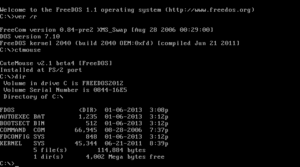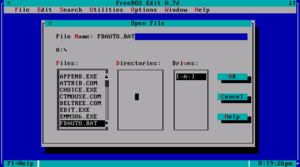FreeDOS
FreeDOS (formerly Free-DOS and PD-DOS) is a free operating system for IBM PC compatible computers. It intends to provide a complete DOS-compatible environment for running legacy software and supporting embedded systems.[7]
 FreeDOS 1.1 default shell, FreeCOM | |
| Developer | Jim Hall & The FreeDOS team |
|---|---|
| Written in | Assembly Language, C[1] |
| OS family | DOS |
| Working state | Current |
| Source model | Open source[2] |
| Initial release | 12 January 1998 |
| Latest release | 1.2 / 25 December 2016[3] |
| Latest preview | 1.3 RC3 / 1 June 2020[4] |
| Repository | |
| Available in | English, German, Dutch |
| Platforms | x86 |
| Kernel type | Monolithic kernel[5] |
| Default user interface | Command-line interface (COMMAND.COM) |
| License | GNU GPL[6] with various different licenses for utilities |
| Official website | www |
FreeDOS can be booted from a floppy disk or USB flash drive.[8][9] It is designed to run well under virtualization or x86 emulation.[10]
Unlike most versions of MS-DOS,[11] FreeDOS is composed of free and open-source software, licensed under the terms of the GNU General Public License.[6] Therefore, its base distribution does not require license fees or royalties and creation of custom distributions is permitted. However, other packages that form part of the FreeDOS project include non-GPL software considered worth preserving, such as 4DOS, which is distributed under a modified MIT License.[12]
History

The FreeDOS project began 29 June 1994, after Microsoft announced it would no longer sell or support MS-DOS. Jim Hall who at the time was a student[13] posted a manifesto proposing the development of PD-DOS, a public domain version of DOS.[14] Within a few weeks, other programmers including Pat Villani and Tim Norman joined the project. Between them, a kernel (by Villani), the COMMAND.COM command line interpreter (by Villani and Norman), and core utilities (by Hall) were created by pooling code they had written or found available.[15][16] For some time, the project was maintained by Morgan "Hannibal" Toal. There have been many official pre-release distributions of FreeDOS before the final FreeDOS 1.0 distribution.[3] GNU/DOS, an unofficial distribution of FreeDOS, was discontinued after version 1.0 was released.[17][18]
Blinky the Fish is the mascot of FreeDOS. He was designed by Bas Snabilie.[19]
Distribution
FreeDOS 1.1, released on 2 January 2012,[20] is available for download as a CD-ROM image: a limited install disc that only contains the kernel and basic applications, and a full disc that contains many more applications (games, networking, development, etc.), not available as of November 2011 but with a newer, fuller 1.2.[21] The legacy version 1.0 (2006) consisted of two CDs, one of which was an 8MB install CD targeted at regular users and the other which was a larger 49MB live CD that also held the source code of the project.[21]
Commercial uses
FreeDOS is used by several companies:
- Dell preloaded FreeDOS with their n-series desktops to reduce their cost. The firm has been criticized for making these machines no cheaper, and harder to buy, than identical systems with Windows.[22]
- HP provided FreeDOS as an option in its dc5750 desktops, Mini 5101 netbooks and Probook laptops.[23][24][25] FreeDOS is also used as bootable media for updating the BIOS firmware in HP systems.[26]
- FreeDOS is included by Steve Gibson's hard drive maintenance and recovery program, SpinRite.[27]
- Intel's Solid-State Drive Firmware Update Tool loads the FreeDOS kernel.[28]
Non-commercial uses
FreeDOS is also used in multiple independent projects:
- FED-UP is the Floppy Enhanced DivX Universal Player.[29]
- FUZOMA is a FreeDOS-based distribution that can boot from a floppy disk and converts older computers into educational tools for children.[30]
- XFDOS is a FreeDOS-based distribution with a graphical user interface, porting Nano-X and FLTK.[31][32][33][34]
Compatibility
| Version | Status | Codename | Date |
|---|---|---|---|
| 0.01 | ALPHA | None | 16 September 1994 |
| 0.02 | ALPHA | None | December 1994 |
| 0.03 | ALPHA | None | January 1995 |
| 0.04 | ALPHA | None | June 1995 |
| 0.05 | ALPHA | None | 10 August 1996 |
| 0.06 | ALPHA | None | November 1997 |
| 0.1 | BETA | Orlando | 25 March 1998 |
| 0.2 | BETA | Marvin | 28 October 1998 |
| 0.3 | BETA | Ventura | 21 April 1999 |
| 0.4 | BETA | Lemur | 9 April 2000 |
| 0.5 | BETA | Lara | 10 August 2000 |
| 0.6 | BETA | Midnite | 18 March 2001 |
| 0.7 | BETA | Spears | 7 September 2001 |
| 0.8 | BETA | Nikita | 7 April 2002 |
| 0.9 | BETA | None | 28 September 2004 |
| 1.0 | FINAL | None | 3 September 2006 |
| 1.1 | FINAL | None | 2 January 2012 |
| 1.2 | FINAL | None | 25 December 2016 |
Hardware
FreeDOS requires a PC/XT machine with at least 640 kB of memory.[37] Programs not bundled with FreeDOS often require additional system resources.
MS-DOS and Win32 console
FreeDOS is mostly compatible with MS-DOS. It supports COM executables, standard DOS executables and Borland's 16-bit DPMI executables. It is also possible to run 32-bit DPMI executables using DOS extenders. The operating system has several improvements relative to MS-DOS, mostly involving support of newer standards and technologies that did not exist when Microsoft ended support for MS-DOS, such as internationalization, or the Advanced Power Management TSRs.[38] Furthermore, with use of HX DOS Extender, many Windows Console applications function properly in FreeDOS, as do some rare GUI programs, like QEMM and Bochs.[39]
DOS-based Windows
FreeDOS is able to run Microsoft Windows 1.0 and 2.0 releases. Windows 3.x releases, which had support for i386 processors, can not fully be run in 386 Enhanced Mode[40] except partially in experimental FreeDOS kernel 2037.
Windows 95, Windows 98 and Windows Me use a stripped-down version of MS-DOS. FreeDOS cannot be used as a replacement because of undocumented interfaces between MS-DOS 7.0-8.0 and Windows "4.xx" are not emulated by FreeDOS; however, it can be installed and used beside these systems using a boot manager program, such as BOOTMGR or METAKERN included with FreeDOS.
Windows NT and ReactOS
Windows NT-based operating systems, including Windows 2000, XP, Vista and 7 for desktops, and Windows Server 2003, 2008 and 2008 R2 for servers, do not make use of MS-DOS as a core component of the system. These systems can make use of the FAT file systems, which are used by MS-DOS and earlier versions of Windows; however, they typically use the NTFS (New Technology File System) by default for security and other reasons. FreeDOS can co-exist on these systems on a separate partition or on the same partition on FAT systems. The FreeDOS kernel can be booted by adding it to the Windows 2000 or XP's NT Boot Loader configuration file, boot.ini,[41] or freeldr.ini equivalent for ReactOS.[42]
File systems

FAT32 is fully supported and is the preferred format for the boot drive.[43] Depending on the BIOS used, up to four Logical Block Addressing (LBA) hard disks up to 128 GB, or 2 TB, in size are supported.[44] There has been little testing with large disks, and some BIOSes support LBA but produce errors on disks larger than 32 GB; a driver such as OnTrack or EZ-Drive resolves this problem. FreeDOS can also be used with a driver called LFNDOS to enable support for Windows 95-style long file names,[45] but most old programs before Windows 95 do not support LFNs, even with a driver loaded. There is no planned support for NTFS, ext2 or exFAT, but there are several external third-party drivers available for that purpose. To access ext2 file systems, LTOOLS, a counterpart to Mtools, can sometimes be used to copy data to and from ext2 file system drives.
References
- "FreeDOS Spec". FreeDOS Wiki. Freedos. 2008-12-24. Retrieved 2017-02-09.
- SourceForge 2018, p. 1: "FreeDOS is […] distributed under the GNU General Public License or a similar open source software license."
- "FreeDOS History". Freedos.org. Retrieved 2019-01-29.
- "FreeDOS 1.3-RC3 now available!". The FreeDOS Project on Sourceforge. Retrieved 2020-06-08.
- Villani, Pat (1996). FreeDOS Kernel. Emeryville, CA, USA: Miller Freeman. ISBN 0-87930-436-7.
- SourceForge 2018.
- "Main Page". FreeDOS Wiki. The FreeDOS Project. Retrieved 2017-02-09.
- Franske, Ben (2007-08-21). "Booting DOS from a USB flash drive". Archived from the original on 2010-02-18. Retrieved 2008-08-04.
- "How to Create a Bootable FreeDOS Floppy Disk". 2005-07-19. Retrieved 2008-08-04.
- Gallagher, Sean (2014-07-14). "Though "barely an operating system," DOS still matters (to some people)". ArsTechnica. Condé Nast. Retrieved 2017-02-09.
But FreeDOS has become much more friendly to virtualization and hardware emulation—it's even the heart of the DOSEMU emulator
- Turner, Rich (2018-09-28). "Re-Open-Sourcing MS-DOS 1.25 and 2.0". Windows Command Line Tools For Developers. Retrieved 2018-09-29.
- "4DOS". FreeDOS. The FreeDOS Project. Retrieved 2014-06-06.
- Hall, Jim interviewed on the TV show FLOSS weekly on the TWiT.tv network
- Hall, Jim (1994-06-29). "PD-DOS project *announcement*". comp.os.msdos.apps. Retrieved 2008-06-14.
- Hall, Jim (2002-03-25). "The past, present, and future of the FreeDOS Project". LinuxGizmos.com. Archived from the original on 2013-12-24. Retrieved 2008-06-14.
- Hall, Jim (2006-09-23). "About". FreeDOS. The FreeDOS Project. Archived from the original on 2007-05-27. Retrieved 2014-06-17.
- Adams, David. "Introducing GNU/DOS 2005". OSNews. Retrieved 2016-11-27.
- Marinof, Mihai. "GNU/DOS Project Discontinued". Retrieved 2016-11-27.
- FreeDOS official logos
- Hall, Jim (2012-01-02). "Announcement on official FreeDOS homepage". SourceForge. Retrieved 2012-01-02.
- "FreeDOS 1.0". FreeDOS.org. The FreeDOS Project. Archived from the original on 2011-11-05. Retrieved 2015-12-21.
- Vance, Ashlee. "How Dell repels attempts to buy its 'open source' PC". The Register. Retrieved 2008-01-02.
- "HP Compaq dc5750 Business PC". Hewlett-Packard. Archived from the original on 2012-11-13. Retrieved 2016-11-27.
- "First Look at HP's Low-Cost ProBook Laptop Lineup". EWeek. Retrieved 2009-03-26.
- McCracken, Harry (2009-06-23). "HP's Mini 5101: Netbook Deluxe, With All the Trimmings". Technologizer. Retrieved 2009-08-01.
- "FreeDOS Bootable Media". Hewlett-Packard. 2010-10-25. Retrieved 2011-01-13.
- Goldstein, Leon A. (2004-07-19). "SpinRite 6.0 for Linux Users". Linux Journal. Retrieved 2017-02-09.
- "Intel SATA Solid-State Drive Firmware Update Tool". Intel. Archived from the original on 2010-03-25. Retrieved 2016-11-27.
- "Floppy Enhanced DivX Universal Player". Retrieved 2009-12-18.
- "FUZOMA Educational Software". Retrieved 2009-12-18.
- kraileth (2012-10-12). "An extraordinary TK example! | eerielinux". Eerielinux.wordpress.com. Retrieved 2019-01-29.
- kraileth (2014-12-30). "An interview with the Nanolinux developer | eerielinux". Eerielinux.wordpress.com. Retrieved 2019-01-29.
- "Artificial Intelligence Methods". Archived from the original on 1999-04-20. Retrieved 2019-01-29.
- "Georg's Personal Homepage". Georgpotthast.de. Retrieved 2019-01-29.
- "FreeDOS software package comparison". Ibiblio.org. Retrieved 2019-01-29.
- Hall, Jim (2007-10-02). "Removing old distributions from ibiblio" (Mailing list). Retrieved 2009-10-07.
- Lowe, Scott (2003-07-22). "Configure IT Quick: Use FreeDOS as a replacement for MS-DOS". TechRepublic. CBS Interactive. Retrieved 2017-02-09.
- Broersma, Matthew (2006-09-04). "DOS lives! Open source reinvents past". Techworld. Archived from the original on 2013-11-02.
- Grech, Andreas. "HX DOS Extender". Archived from the original on 2014-10-03.
- Santamaria-Merino, Aitor (2014-09-03). "Windows on FreeDOS?". FreeDOS. Retrieved 2017-02-09.
- Herbert, Marc (2004-10-01). "Install FreeDOS without any CD, floppy, USB-key, nor any other removable media". Retrieved 2009-05-26.
- "FreeLoader — ReactOS Wiki". reactos.org. Retrieved 2017-06-30.
- Hilpert, Dominik (2015-05-07). "Creating a Bootable DOS USB Stick". Retrieved 2017-02-09.
- Mueller, Scott (2013-03-22). Upgrading and Repairing PCs (21st ed.). Que Publishing.
- Gallagher, Sean (2014-07-03). "Old school: I work in DOS for an entire day". ArsTechnica. Condé Nast. Retrieved 2017-02-09.
Sources
- SourceForge (2018-09-14), The FreeDOS Project, Slashdot Media
External links
| Wikimedia Commons has media related to FreeDOS. |
- Official website

- FreeDOS on SourceForge.net
- FD-DOC FreeDOS Documentation Project
- Official Download — FreeDOS 1.2
- Summary of FreeDOS Commands
- FreeDOS help (commands and usage)
- How to Create a BootableFreeDOS Floppy Disk
- FreeDOS bootdisk with several DOS utilities
- FreeDOS USB Boot Image
- Install FreeDOS without any removable media.